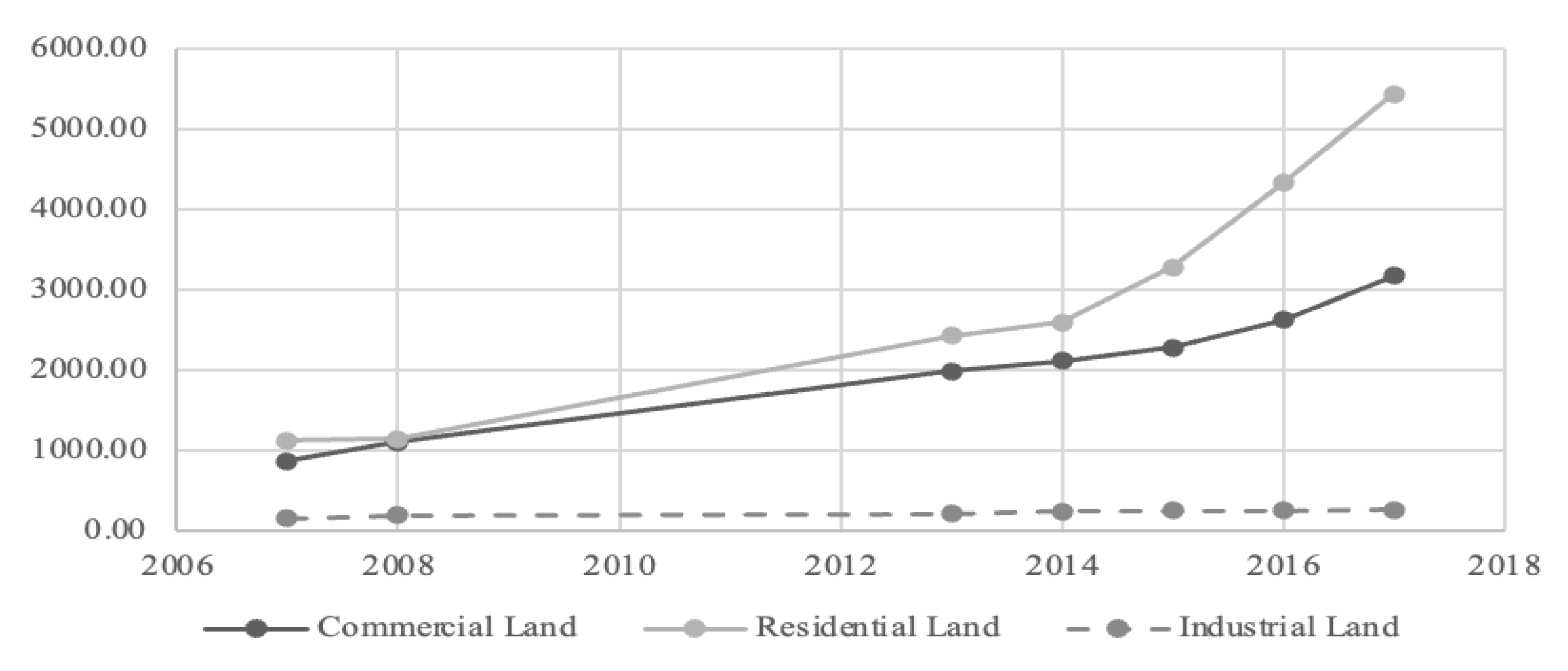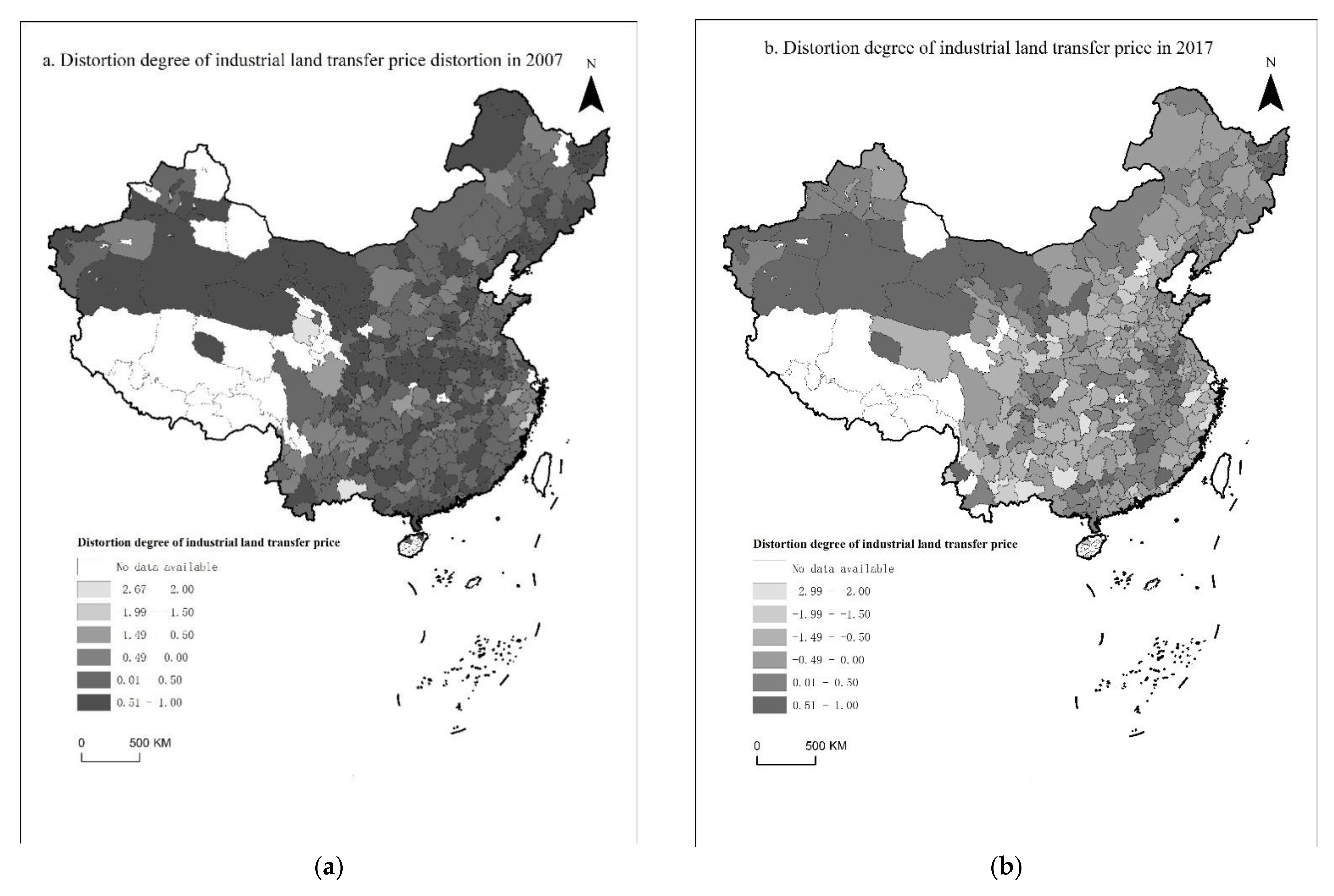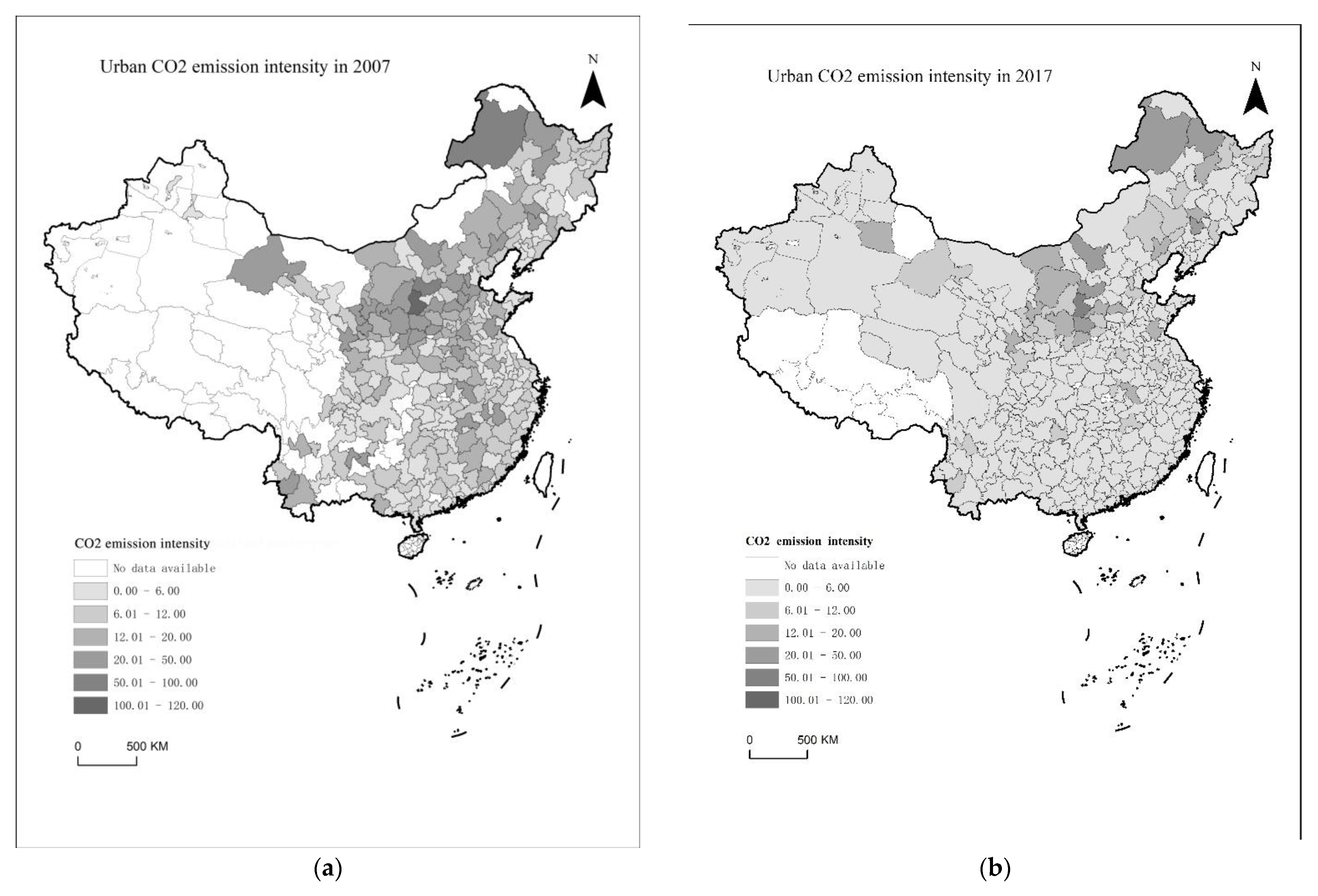Exploring the Impact of Industrial Land Price Distortion on Carbon Emission Intensity: Evidence from China
Abstract
:1. Introduction
2. Model Setting, Variable Selection, and Data Sources
2.1. Model Setting
2.1.1. Multiple Linear Regression Model
2.1.2. Heterogeneity Effect Analysis
2.1.3. Mediating Effect Model
2.2. Data Sources
2.3. Variable Selection
3. Degree of Industrial Land-Transfer Price Distortion and Spatial–Temporal Evolution Characteristics of Carbon Emission Intensity
3.1. Distortion of Industrial Land-Transfer Price
3.2. Carbon Emission Intensity
4. Empirical Results
4.1. Correlation Analysis
4.2. Benchmark Regression Analysis
4.3. Heterogeneity Analysis
4.3.1. Regional Heterogeneity
4.3.2. Heterogeneity of Urban Scale
4.3.3. Heterogeneity of Fiscal Self-Financing Degree
4.4. Intermediate Mechanism Examination
5. Conclusions and Policy Implications
Author Contributions
Funding
Data Availability Statement
Conflicts of Interest
References
- Wang, S.; Zhou, C.; Li, G.; Feng, K.H. CO2, economic growth, and energy consumption in China’s provinces: Investigating the spatiotemporal and econometric characteristics of China’s CO2 emissions. Ecol. Indic. 2016, 69, 184–195. [Google Scholar] [CrossRef]
- Tang, P.; Yang, S.; Fu, S. Do political incentive affects China’s land transfer in energy-intensive industries? Energy 2018, 164, 550–559. [Google Scholar] [CrossRef]
- Liu, Y.; Alm, J. Province-Managing-County’ Fiscal Reform, Land Expansion, and Urban Growth in China. J. Hous. Econ. 2016, 33, 82–100. [Google Scholar] [CrossRef] [Green Version]
- Li, H.B.; Zhou, L.A. Political turnover and economic performance: The incentive role of personnel control in China. J. Public Econ. 2004, 89, 1743–1762. [Google Scholar] [CrossRef]
- Deng, H.; Zheng, X.; Huang, N.; Li, F.H. Strategic Interaction in Spending on Environmental Protection: Spatial Evidence from Chinese Cities. China World Econ. 2012, 20, 103–120. [Google Scholar] [CrossRef]
- Huang, Z.H.; Du, X.J. Government intervention and land misallocation: Evidence from China. Cities 2017, 60, 323–332. [Google Scholar] [CrossRef]
- Hsieh, C.T.; Moretti, E. Housing constraints and spatial. Am. Econ. J. Macroecon. 2019, 11, 1–39. [Google Scholar] [CrossRef] [Green Version]
- Du, J.; Peiser, R.B. Land supply, pricing and local governments’ land hoarding in China. Reg. Sci. Urban Econ. 2014, 48, 180–189. [Google Scholar] [CrossRef]
- Meng, Y.; Zhang, F.R.; An, P.L.; Dong, M.L.; Wang, Z.Y.; Zhao, T.T. Industrial Land-use Efficiency and Planning in Shunyi, Beijing. Landsc. Urban Plan. 2008, 85, 40–48. [Google Scholar] [CrossRef]
- Du, J.; Mickiewicz, T. Subsidies, rent seeking and performance: Being young, small or private in China. J. Bus. Ventur. 2016, 31, 22–38. [Google Scholar] [CrossRef]
- Glaeser, E.L.; Kahn, M.E. The greenness of cities: Carbon dioxide emission and urban development. J. Urban Econ. 2010, 67, 404–418. [Google Scholar] [CrossRef] [Green Version]
- Zhou, L.; Tian, L.; Gao, Y.; Yingkai Ling, Y.K.; Fan, C.J.; Hou, D.Y.; Shen, T.Y.; Zhou, E.T. How did industrial land supply respond to transitions in state strategy? An analysis of prefecture-level cities in China from 2007 to 2016. Land Use Policy 2019, 87, 104009. [Google Scholar] [CrossRef]
- Yang, M.; Yang, F.X.; Sun, C.Y. Factor market distortion correction, resource reallocation and potential productivity gains: An empirical study on China’s heavy industry sector. Energy Econ. 2018, 69, 270–279. [Google Scholar] [CrossRef]
- Wu, H.; Guo, H.; Zhang, B.; Bu, M.L. Westward movement of new polluting firms in China: Pollution reduction mandates and location choice. J. Comp. Econ. 2017, 45, 119–138. [Google Scholar] [CrossRef]
- Lin, B.Q.; Chen, Z.Y. Does factor market distortion inhibit the green total factor productivity in China? J. Clean. Prod. 2018, 197, 25–33. [Google Scholar] [CrossRef]
- Ren, S.G.; Yuan, B.L.; Ma, X.; Chen, X.H. International trade, FDI (foreign direct investment) and embodied CO2 emissions: A case study of Chinas industrial sectors. China Econ. Rev. 2014, 28, 123–134. [Google Scholar] [CrossRef]
- Lv, J.K.; Sun, J.G. Temporal and Spatial Changes of Land Use in Donghe District of Baotou City and Its Impact on Ecological Environment. IOP Conf. Ser. Earth Environ. Sci. 2021, 766, 012067. [Google Scholar] [CrossRef]
- Francesco, T.; Fabio, I.; Marco, F. The Effect of Environmental Regulation on Firms’ Competitive Performance: The Case of the Building & Construction Sector in Some EU Regions. J. Environ. Manag. 2011, 92, 2136–2144. [Google Scholar]
- Baek, J. Environmental Kuznets curve for CO2 emissions: The case of Arctic countries. Energy Econ. 2015, 50, 13–17. [Google Scholar] [CrossRef]
- Théophile, A.; Francois, L.; Phu, N.V. Economic development and CO2 emissions: A nonparametric panel approach. J. Public Econ. 2006, 6, 1347–1363. [Google Scholar]
- Sun, L.L.; Cui, H.J.; Ge, Q.S. Will China achieve its 2060 carbon neutral commitment from the provincial perspective? Adv. Clim. Change Res. 2022, 13, 169–178. [Google Scholar] [CrossRef]
- Shobande, O.A. Decomposing the Persistent and Transitory Effect of Information and Communication Technology on Environmental Impacts Assessment in Africa: Evidence from Mundlak Specification. Sustainability 2021, 13, 4683. [Google Scholar] [CrossRef]
- Liu, J.H.; Li, J.H.; Ding, Y.T. Econometric analysis of the impact of the urban population size on carbon dioxide (CO2) emissions in China. Environ. Dev. Sustain. 2021, 23, 18186–18203. [Google Scholar] [CrossRef]
- Pan, B.B.; Zhang, Y.L. Impact of affluence, nuclear and alternative energy on US carbon emissions from 1960 to 2014. Energy Strategy Rev. 2020, 32, 100581. [Google Scholar] [CrossRef]
- Ling, Y.T.; Xia, S.M.; Cao, M.Q.; He, K.R.; He, K.R.; Lim, M.K.; Sukumar, A.; Yi, H.Y.; Qian, X.D. Carbon emissions in China’s thermal electricity and heating industry: An input-output structural decomposition analysis. J. Clean. Prod. 2021, 329, 0959–6526. [Google Scholar] [CrossRef]
- Yu, X.; Wu, Z.; Zheng, H.; Li, M.Q.; Tan, T.L. How urban agglomeration improve the emission efficiency? A spatial econometric analysis of the Yangtze River Delta urban agglomeration in China. J. Environ. Manag. 2020, 260, 110061. [Google Scholar] [CrossRef]
- Zhang, J.N.; Wang, J.L.; Yang, X.D.; Ren, S.Y.; Ran, Q.Y.; Hao, Y. Does local government competition aggravate haze pollution? A new perspective of factor market distortion. Socio-Econ. Plan. Sci. 2020, 76, 100959. [Google Scholar] [CrossRef]
- Li, W.X.; Fan, Y. Influence of green finance on carbon emission intensity: Empirical evidence from China based on spatial metrology. Environ. Sci. Pollut. Res. Int. 2022, 22, 23523. [Google Scholar] [CrossRef]
- Liu, X.J.; Jin, X.B.; Luo, X.L.; Zhou, Y.K. Multi-scale variations and impact factors of carbon emission intensity in China. Sci. Total Environ. 2022, 857, 159403. [Google Scholar] [CrossRef]
- Zhang, W.; XU, H.Z. Effects of land urbanization and land finance on carbon emissions: A panel data analysis for Chinese provinces. Land Use Policy 2017, 63, 493–500. [Google Scholar] [CrossRef] [Green Version]
- Van der Kamp, D.; Lorentzen, P.; Mattingly, D. Racing to the bottom or to the top? Decentralization, revenue pressures, and governance reform in China. World Dev. 2017, 95, 164–176. [Google Scholar] [CrossRef]
- Lin, B.; Abudu, H. Changes in Energy Intensity during the Development Process: Evidence in Sub-Saharan Africa and Policy Implications. Energy 2019, 183, 1012–1022. [Google Scholar] [CrossRef]
- Wang, H.; Chen, Z.; Wu, X.; Nie, X. Can a carbon trading system promote the transformation of a low-carbon economy under the framework of the porter hypothesis? —Empirical analysis based on the PSM-DID method. Energy Policy 2019, 129, 930–938. [Google Scholar] [CrossRef]
- Campbell, C.A.; Zentner, R.P.; Liang, B.C.; Roloff, G.; Gregorich, E.C.; Blomert, B. Organic C accumulation in soil over 30 years in semiarid southwestern Saskatchewan–Effect of crop rotations and fertilizers. Can. J. Soil Sci. 2000, 80, 179–192. [Google Scholar] [CrossRef]
- Bartelsman, E.; Haltiwanger, J.; Scarpetta, S. Cross-Country Differences in Productivity: The Role of Allocation and Selection. Am. Econ. Rev. 2013, 103, 305–334. [Google Scholar] [CrossRef] [Green Version]
- Meng, X.N.; Xu, S.C.; Zhang, J.N. How does industrial intelligence affect carbon intensity in China? Empirical analysis based on Chinese provincial panel data. J. Clean. Prod. 2022, 376, 134273. [Google Scholar] [CrossRef]
- Balli, H.O.; Sørensen, B.E. Interaction effects in econometrics. Empir. Econ. 2013, 45, 583–603. [Google Scholar] [CrossRef] [Green Version]
- Robins, J.M.; Greenland, S. Identifiability and exchangeability for direct and indirect effects. Epidemiol. 1992, 3, 143–155. [Google Scholar] [CrossRef] [Green Version]
- Chen, J.; Gao, M.; Cheng, S.; Liu, X.; Hou, W.X.; Song, M.L.; Li, D.; Fan, W. China’s city-level carbon emissions during 1992–2017 based on the inter-calibration of nighttime light data. Sci. Rep. 2021, 11, 3323. [Google Scholar] [CrossRef]
- Paul, K. Increasing Returns and Economic Geography. J. Political Econ. 1991, 99, 483–499. [Google Scholar]
- Yan, Y.; Liu, T.; Wang, N.C.; Yao, S.J. Urban sprawl and fiscal stress: Evidence from urbanizing China. Cities 2022, 126, 103699. [Google Scholar] [CrossRef]
- Zhang, X.L.; Lin, Y.L.; Wu, Y.Z.; Skitmore, M. Industrial land price between China’s Pearl River Delta and Southeast Asian regions: Competition or Coopetition? Land Use Policy 2017, 61, 575–586. [Google Scholar] [CrossRef]






| Variable | Abbreviation | Unit | Mean | Standard Error | Min | Max | Sample Capacity |
|---|---|---|---|---|---|---|---|
| Carbon emission intensity | lnCEI | Tons/billion | 11.096 | 0.922 | 7.820 | 14.243 | 3149 |
| Degree of industrial land-transfer distortion | Landdist | - | −0.005 | 0.628 | −2.986 | 0.990 | 3525 |
| Rationalization of industrial structure | TL | - | 0.179 | 0.194 | 0 | 1.936 | 2804 |
| Advancement of industrial structure | Moore | - | 6.731 | 0.325 | 5.381 | 7.607 | 3100 |
| Opening-up level | open | - | 0.495 | 0.053 | 0 | 0.480 | 2805 |
| Energy intensity | energy | Million tons/billion yuan | 0.282 | 0.290 | 0.009 | 7.860 | 3149 |
| Secondary industry structure | secondary | % | 0.495 | 0.121 | 0.097 | 0.910 | 3101 |
| Urbanization level | urban | % | 0.520 | 0.150 | 0.170 | 1 | 2545 |
| Per capita disposable income | income | million yuan | 1.635 | 0.542 | 0.535 | 4.260 | 3186 |
| lnCEI | Landdist | Open | Energy | Secondary | Urban | Income | TL | Moore | |
|---|---|---|---|---|---|---|---|---|---|
| lnCEI | 1 | ||||||||
| Landdist | 0.129 *** | 1 | |||||||
| open | 0.238 *** | 0.0210 | 1 | ||||||
| energy | 0.176 *** | 0.129 *** | −0.0140 | 1 | |||||
| secondary | −0.146 *** | 0.233 *** | −0.036 * | 0.062 *** | 1 | ||||
| urban | −0.641 *** | −0.180 *** | −0.060 *** | −0.057 *** | −0.00800 | 1 | |||
| income | −0.581 *** | −0.416 *** | -0.0130 | −0.075 *** | −0.098 *** | 0.647 *** | 1 | ||
| TL | 0.194 *** | −0.00900 | −0.045 ** | −0.119 *** | −0.191 *** | −0.449 *** | −0.216 *** | 1 | |
| Moore | −0.189 *** | −0.296 *** | 0.098 *** | 0.062 *** | −0.344 *** | 0.474 *** | 0.433 *** | −0.613 *** | 1 |
| (1) | (2) | (3) | |
|---|---|---|---|
| Landdist | 0.169 *** (5.56) | 0.031 *** (3.32) | 0.021 ** (2.51) |
| secondary | −0.679 *** (−10.19) | −0.949 *** (−14.61) | |
| energy | 0.236 *** (7.05) | 0.256 *** (8.50) | |
| open | 1.394 *** (12.45) | 1.364 *** (13.59) | |
| income | −0.343 *** (−32.72) | 0.057 ** (2.43) | |
| urban | −2.429 *** (−19.62) | −0.826 *** (−6.20) | |
| Constant | 11.060 *** (646.41) | 12.260 *** (131.24) | 10.043 *** (75.00) |
| Urban fixed effect | NO | YES | YES |
| Time fixed effect | NO | NO | YES |
| Sample capacity | 2826 | 2049 | 2049 |
| R2 | 0.011 | 0.984 | 0.987 |
| Eastern Region | Central Region | Western Region | |
|---|---|---|---|
| Landdist | 0.023 * (1.66) | 0.026 ** (2.02) | −0.009 (−0.58) |
| secondary | −0.977 *** (−9.02) | −1.036 *** (−11.66) | −0.860 *** (−4.10) |
| energy | 0.322 *** (6.44) | 0.300 *** (6.78) | 0.067 (1.00) |
| open | 1.506 *** (9.61) | 0.836 *** (5.45) | 0.674 (1.16) |
| income | 0.090 *** (3.07) | −0.058 (−1.12) | 0.115 (1.36) |
| urban | −1.003 *** (−4.41) | −0.943 *** (−5.21) | 1.226 ** (2.43) |
| Constant | 10.108 *** (49.53) | 11.684 *** (71.44) | 10.204 *** (35.34) |
| Urban fixed effect | YES | YES | YES |
| Time fixed effect | YES | YES | YES |
| Sample capacity | 950 | 832 | 267 |
| R2 | 0.987 | 0.987 | 0.989 |
| Small Cities | Medium−Sized Cities | Large Cities | |
|---|---|---|---|
| Landdist | 0.045 (1.32) | 0.028 ** (2.34) | 0.006 (0.51) |
| secondary | −3.125 *** (−8.71) | −0.885 *** (−9.92) | −0.804 *** (−8.10) |
| energy | −0.131 (−0.64) | 0.309 *** (7.21) | 0.175 *** (4.24) |
| open | 2.619 (1.35) | 1.448 *** (10.58) | 1.288 *** (8.28) |
| income | −0.052 (−0.45) | 0.080 ** (2.15) | 0.086 *** (2.75) |
| urban | 0.807 * (1.98) | −1.270 *** (−5.63) | −0.505 ** (−2.19) |
| Constant | 12.578 *** (45.37) | 12.102 *** (95.89) | 9.714 *** (41.77) |
| Urban fixed effect | YES | YES | YES |
| Time fixed effect | YES | YES | YES |
| Sample capacity | 50 | 1147 | 838 |
| R2 | 0.990 | 0.986 | 0.991 |
| Fiscal Self-Financing Degree above 50% | Fiscal Self-Financing Degree below 50% | |
|---|---|---|
| Landdist | 0.003 (0.25) | 0.030 ** (2.58) |
| secondary | −0.612 *** (−5.89) | −1.461 *** (−15.69) |
| energy | 0.380 *** (7.97) | 0.140 *** (3.63) |
| open | 1.341 *** (9.99) | 1.359 *** (8.40) |
| income | 0.080 *** (2.77) | 0.090 * (1.84) |
| urban | −0.379 ** (−2.24) | −1.787 *** (−6.95) |
| Constant | 9.530 *** (56.47) | 12.511 *** (75.35) |
| Urban fixed effect | YES | YES |
| Time fixed effect | YES | YES |
| Sample capacity | 1109 | 849 |
| R2 | 0.989 | 0.988 |
| Rationalization of Industrial Structure (TL) | Advancement of Industrial Structure (Moore) | Model (1) | |||
|---|---|---|---|---|---|
| Landdist | −0.001 (−0.20) | 0.018 ** (2.00) | −0.010 ** (−2.23) | 0.020 ** (2.35) | 0.021 ** (2.52) |
| TL | 0.002 (0.06) | ||||
| Moore | −0.122 *** (−2.88) | ||||
| Control variables | Control | Control | Control | Control | Control |
| Time and region control | YES | YES | YES | YES | YES |
| R2 | 0.896 | 0.987 | 0.970 | 0.988 | 0.987 |
Disclaimer/Publisher’s Note: The statements, opinions and data contained in all publications are solely those of the individual author(s) and contributor(s) and not of MDPI and/or the editor(s). MDPI and/or the editor(s) disclaim responsibility for any injury to people or property resulting from any ideas, methods, instructions or products referred to in the content. |
© 2022 by the authors. Licensee MDPI, Basel, Switzerland. This article is an open access article distributed under the terms and conditions of the Creative Commons Attribution (CC BY) license (https://creativecommons.org/licenses/by/4.0/).
Share and Cite
Gao, B.-y.; Huang, Z.-j.; Zhang, T.-t.; Sun, X.-y.; Song, M.-y. Exploring the Impact of Industrial Land Price Distortion on Carbon Emission Intensity: Evidence from China. Land 2023, 12, 92. https://doi.org/10.3390/land12010092
Gao B-y, Huang Z-j, Zhang T-t, Sun X-y, Song M-y. Exploring the Impact of Industrial Land Price Distortion on Carbon Emission Intensity: Evidence from China. Land. 2023; 12(1):92. https://doi.org/10.3390/land12010092
Chicago/Turabian StyleGao, Bo-yang, Zhi-ji Huang, Ting-ting Zhang, Xiao-yu Sun, and Ming-yue Song. 2023. "Exploring the Impact of Industrial Land Price Distortion on Carbon Emission Intensity: Evidence from China" Land 12, no. 1: 92. https://doi.org/10.3390/land12010092
APA StyleGao, B.-y., Huang, Z.-j., Zhang, T.-t., Sun, X.-y., & Song, M.-y. (2023). Exploring the Impact of Industrial Land Price Distortion on Carbon Emission Intensity: Evidence from China. Land, 12(1), 92. https://doi.org/10.3390/land12010092




